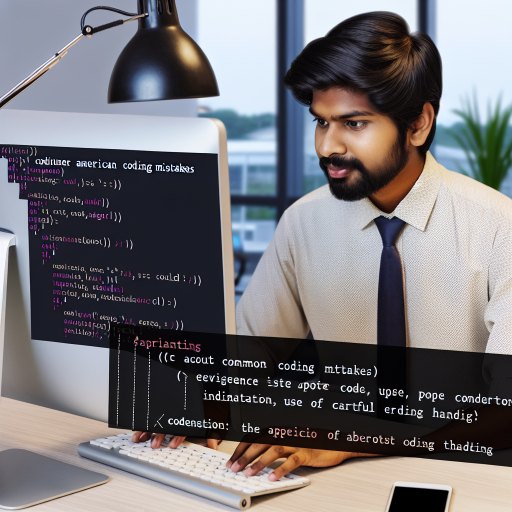Introduction
Understanding coding syntax, the rules guiding symbol and keyword combinations, is crucial for a seamless syntax coding experience.
Just as grammar is vital in natural languages, syntax is crucial in coding.
Proper syntax ensures that a program functions correctly and performs the intended tasks.
For beginners, understanding syntax is essential for a smooth entry into programming.
Many new coders face challenges while writing code, often becoming frustrated due to syntax errors.
Recognizing these rules early on can significantly enhance their learning experience, leading to a stronger foundation.
A recent survey found that over 60% of beginner programmers struggle primarily with syntax-related issues.
This statistic underscores the importance of mastering syntax to mitigate early frustrations in coding.
By focusing on these rules, new coders can avoid common pitfalls, such as forgetting semicolons, using incorrect brackets, or mismatching data types.
Defining Syntax in Programming
Syntax refers to the set of rules that defines the structure of a programming language.
It dictates how programmers write instructions for computers to execute.
Just like grammar in spoken language, syntax in programming languages prevents ambiguity and misunderstanding.
Each programming language has its own specific syntax.
This ensures that the language remains consistent and functional.
Here are the main characteristics of programming syntax:
- Keywords: Reserved words in a language that have special meanings, like
if,else,for, andreturn. - Operators: Symbols that perform operations on variables, such as
+for addition and-for subtraction. - Punctuation: Characters that organize code, like commas, semicolons, and parentheses.
- Structure: The arrangement of code blocks, including functions, loops, and conditionals.
Comparison of Syntax in Spoken Language to Programming Syntax
While both spoken languages and programming languages rely heavily on syntax, they serve different purposes.
Spoken language is meant for human communication, while programming syntax commands computers.
Here’s how they compare:
- Structure: Just as a sentence requires a subject and verb, a coding statement needs specific keywords and format.
- Order: The sequence of words or symbols impacts meaning in both languages.
For example, “The dog runs” is different from “Runs the dog.” - Ambiguity: In spoken language, context often clarifies meaning.
In programming, ambiguity leads to errors. - Rules: Each language has unique syntactical rules that must be followed for clarity and correctness.
Importance of Strict Adherence to Syntax Rules
Understanding and adhering to syntax rules is critical in programming.
Here’s why:
- Prevents Errors: Small syntax errors, such as forgetting a semicolon, can lead to significant errors in the code.
- Enhances Readability: Clean, organized code is easier for programmers to read and understand later on.
- Facilitates Debugging: Well-structured code aids in quickly identifying and fixing issues.
- Promotes Consistency: Following syntax rules leads to uniformity, making collaboration easier for teams.
- Improves Learning Curve: Grasping syntax helps beginners transition to complex programming concepts.
When you start coding, becoming familiar with syntax is paramount.
It forms the foundation for everything you will learn.
By paying attention to syntax, you set yourself up for success in your programming journey.
The next section will delve into how mastering syntax can elevate your coding experience.
Common Syntax Errors Beginners Face
When starting with coding, beginners often struggle with syntax errors.
These errors can be frustrating and discouraging.
However, recognizing and understanding them is crucial for growth.
In this section, we will explore common syntax errors.
We will also examine their impact on beginners’ learning experiences.
Overview of Typical Syntax Errors
Syntax errors are mistakes in the code that violate the grammatical rules of the programming language.
Here are some typical syntax errors beginners encounter:
- Missing Semicolons: Many languages, like Java and JavaScript, require semicolons to end statements.
Forgetting to include them can lead to errors. - Incorrect Indentation: Languages such as Python heavily rely on indentation.
Improperly indented code can cause unexpected behavior. - Mismatched Brackets: When coding, every opening bracket must have a matching closing bracket.
Mismatched brackets can confuse the compiler. - Misspelled Keywords: Accidentally typing keywords incorrectly can throw syntax errors.
Such small mistakes can halt code execution. - Incorrect Use of Quotes: In languages like Python and JavaScript, using the wrong type of quote can lead to syntax issues.
Examples of Common Errors in Popular Programming Languages
Let’s look at specific examples of common errors in popular programming languages.
Python
Python relies heavily on indentation.
This keeps the code organized and readable.
However, beginners often misplace or forget indentations.
Consider this example:
def greet(name):
print("Hello, " + name)
This code snippet will raise an indentation error.
To fix it, ensure the print statement is correctly indented:
def greet(name):
print("Hello, " + name)
Another common error is forgetting colons at the end of function declarations:
def greet(name)
print("Hello, " + name)
Notice the missing colon after “greet(name)”.
This will also cause a syntax error.
Tech Consulting Tailored to Your Coding Journey
Get expert guidance in coding with a personalized consultation. Receive unique, actionable insights delivered in 1-3 business days.
Get StartedJava
Java requires a semicolon at the end of each statement.
Without it, the code won’t compile.
For instance:
public class HelloWorld {
public static void main(String[] args) {
System.out.println("Hello, World")
}
}
The missing semicolon after the print statement will lead to a compilation error.
Correcting it involves adding the semicolon:
public class HelloWorld {
public static void main(String[] args) {
System.out.println("Hello, World");
}
}
Moreover, mismatched brackets are a frequent pitfall:
public class HelloWorld {
public static void main(String[] args) {
System.out.println("Hello, World");
}
In this example, the opening bracket for the method does not have a matching closing bracket, leading to a syntax error.
JavaScript
JavaScript is another language where syntax errors frequently occur.
Missing semicolons can create issues:
let message = "Hello, World"
console.log(message)
Here, the missing semicolon at the end of the first line may not always cause an error.
However, it can lead to unexpected behavior in certain scenarios.
Additionally, JavaScript can throw errors if developers mix up function declarations:
function sayHello {
console.log("Hello!");
}
This snippet is missing parentheses after the function name.
It should be:
function sayHello() {
console.log("Hello!");
}
The Impact of These Errors on the Learning Process
Syntax errors can affect the learning process in several ways.
Here are some consequences:
- Frustration: Constantly encountering syntax errors can frustrate beginners.
This frustration can discourage learners from continuing. - Lack of Confidence: When beginners struggle with syntax, they may doubt their coding abilities.
This lack of confidence can hinder progress. - Time Consumption: Debugging syntax errors takes time.
Beginners might spend long hours resolving simple mistakes. - Negative Learning Experience: Frequent syntax errors can create a negative perception of coding.
This can lead to a lack of interest in programming.
However, understanding syntax errors can provide a strong foundation for coding skills.
Beginners who learn to identify and resolve syntax errors develop resilience.
They also improve problem-solving skills.
Here are some strategies to cope with syntax errors:
- Read Error Messages: Compilers and interpreters provide error messages.
Beginners should pay attention to them as they guide debugging. - Practice Debugging: Regular practice helps learners improve their debugging skills over time.
Frequent practice builds familiarity with common errors. - Use Development Tools: Development environments often highlight syntax errors.
Using these tools can help beginners identify issues quickly. - Learn from Examples: Reviewing code examples can enhance understanding.
Beginners may learn proper syntax and common error types from others.
In fact, understanding syntax errors is essential for beginners.
By recognizing common issues, learners can troubleshoot and improve their coding experiences.
Syntax errors may be frustrating, but they offer valuable learning opportunities.
As beginners grow in their understanding, they will build confidence and skills.
Read: Java and Android: A Comprehensive Guide to Mobile Dev
The Learning Curve: Syntax and Its Challenges
When beginners first venture into coding, a steep learning curve often greets them.
The syntax of a programming language presents numerous challenges.
This complex structure comprises rules and conventions that define how code should be written.
Understanding syntax is crucial, as it can greatly impact one’s coding experience.
Build Your Vision, Perfectly Tailored
Get a custom-built website or application that matches your vision and needs. Stand out from the crowd with a solution designed just for you—professional, scalable, and seamless.
Get StartedInitial Difficulty Beginners Face with Syntax
Many newcomers stumble over the intricacies of syntax.
Programming languages may vary significantly from one another.
Each language has different syntax, which can confuse beginners.
Common issues they encounter include:
- Bracket Matching: Forgetting to close brackets or parentheses often leads to errors.
- Variable Naming: Using reserved keywords can create complications in code.
- Indentation: In languages like Python, incorrect indentation can lead to runtime errors.
- Data Types: Misunderstanding data types often results in type errors.
These hurdles can quickly discourage learners.
When they type code and receive error messages, confusion ensues.
The syntax requirements of programming languages can feel overwhelming.
Beginners may feel lost and unsure of how to proceed.
They may question their choice to learn code altogether.
The Cognitive Load of Familiarizing Oneself with Syntactical Rules
Learning a coding language requires more than mere exposure to its syntax.
Beginners must also familiarize themselves with various syntactical rules.
This process generates cognitive load, making it harder to learn effectively.
Cognitive load refers to the mental effort required to understand something new.
Beginners often manage multiple components when learning a programming language.
They need to simultaneously grasp syntax rules, logic, programming concepts, and problem-solving skills.
This overwhelming amount of information can lead to mental fatigue.
Key factors contributing to cognitive load include:
- Simultaneous Learning: Beginners often juggle learning syntax along with other programming principles.
- Complexity: Certain programming languages have intricate syntax rules that require time to master.
- Context: Understanding when and why to use specific syntactical elements can be challenging.
This cognitive load can hinder the learning experience.
As learners struggle to process new information, their motivation can wane.
They might feel overwhelmed by the sheer volume of content.
This situation can lead to frustration and disengagement.
How Improper Understanding Leads to Frustration and Disengagement
Beginners who misunderstand syntax often face dire consequences.
Their initial excitement about coding may quickly evaporate when they encounter challenges.
Common pitfalls include:
- Syntax Errors: Beginners may miss minor errors in their code, which can halt progress.
- Logical Errors: Misunderstanding syntax can lead to incorrect output, further compounding frustration.
- Overwhelm: Struggling to grasp concepts can make it difficult to build confidence in coding.
This sense of helplessness can easily manifest as frustration.
Many learners might give up on their coding journey before truly starting.
Others may consider programming as an insurmountable challenge, leading to disengagement.
When this happens, the potential benefits of coding go unrealized.
Overcoming the Challenges of Syntax
While the challenges of understanding syntax may seem daunting, they can be conquered.
With effective strategies, beginners can navigate the learning curve effectively.
Here are some practical approaches:
- Structured Learning: Beginners benefit from following a structured curriculum that progressively builds knowledge.
- Hands-On Practice: Regular coding practice helps reinforce syntactical rules and reduces cognitive load.
- Code Review: Engaging with experienced programmers can clarify misunderstandings and correct errors.
- Utilize Online Resources: Many websites offer syntax guides, tutorials, and coding exercises.
By utilizing these strategies, beginners can ground their understanding of syntax.
They can build a strong foundation, mitigating frustration and enhancing motivation.
Improving familiarity with syntax allows learners to approach coding with confidence.
The Path Forward
Ultimately, mastery of syntax is a fundamental element of learning to code.
Recognizing the challenges associated with learning syntax enables beginners to strategize effectively.
Early difficulties should not derail the coding journey. Instead, treating these hurdles as stepping stones leads to growth.
Understanding syntax equips learners with the necessary tools for success.
Embracing the struggle prepares them for the many coding adventures to come.
With persistence and support, anyone can conquer the syntax challenges they face.
So, beginners, remember: every great coder started with a blank screen and some initial confusion.
By addressing and overcoming the barriers posed by syntax, you can become an adept programmer in no time.
Stay resilient, keep coding, and soon the syntax will feel like second nature.
Read: Exploring Java’s Importance in Enterprise-Level Projects

Resources for Understanding Syntax
Mastering syntax forms the backbone of successful coding.
Several resources help newcomers grasp this essential aspect.
Here’s a detailed look at various tools that can enhance your understanding of coding syntax.
Optimize Your Profile, Get Noticed
Make your resume and LinkedIn stand out to employers with a profile that highlights your technical skills and project experience. Elevate your career with a polished and professional presence.
Get NoticedRecommended Books
- “Clean Code: A Handbook of Agile Software Craftsmanship” by Robert C. Martin: This book stresses the importance of writing clean and understandable code, emphasizing syntax’s role.
- “Programming Foundations: Fundamentals” by Simon Allardice: A great starting point for understanding programming principles and syntax.
- “Automate the Boring Stuff with Python” by Al Sweigart: This book introduces Python syntax in a practical, engaging way, perfect for beginners.
- “Eloquent JavaScript” by Marijn Haverbeke: Dive deep into JavaScript syntax while exploring the language’s capabilities.
Online Courses
- Codecademy: Offers interactive coding exercises that cover multiple languages and their syntax.
- Coursera: Programming for Everybody (Getting Started with JavaScript): This course covers essential JavaScript, including syntax in depth.
- edX: Introduction to Computer Science and Programming Using Python: Focuses on Python syntax while introducing fundamental programming concepts.
- Khan Academy: Intro to JS: Drawing & Animation: Aimed at beginners, allowing them to learn JavaScript syntax through engaging visual projects.
Tutorials That Focus on Syntax
- W3Schools: Offers easy-to-follow tutorials that break down the syntax of various programming languages.
- freeCodeCamp: Features condensed tutorials focusing on syntax, including interactive coding challenges.
- MDN Web Docs: Provides comprehensive documentation on JavaScript, with a strong emphasis on syntax details.
- The Odin Project: An open-source curriculum with a strong focus on web development, emphasizing syntax learning.
The Importance of IDEs
Using Integrated Development Environments (IDEs) greatly enhances syntax understanding and coding efficiency.
Here’s how:
- Syntax Highlighting: IDEs like Visual Studio Code and PyCharm offer color-coded text.
This helps you distinguish keywords, variables, and other elements. - Error Detection: IDEs provide immediate feedback on syntax errors.
This instant recognition aids beginners in correcting mistakes quickly. - Code Completion: Features like intelligent code completion suggest syntax as you type.
This assists in learning correct syntax usage dynamically. - Debugging Tools: IDEs often include debugging tools that highlight erroneous syntax, making it easier to fix problems.
Community Resources
Engaging with the coding community can significantly enhance your syntax understanding.
Here are some community resources to consider:
- Stack Overflow: A popular forum where coders ask and answer questions related to syntax and coding errors.
- GitHub: Explore projects and resources shared by others.
Real-world code can provide insights into syntax usage. - Reddit (r/learnprogramming): A community that shares tips, resources, and answers questions about programming and syntax.
- Coding Bootcamps: Programs like General Assembly and Le Wagon offer immersive learning experiences focused on coding fundamentals, including syntax.
Joining Mores Specialized Forums
- Dev.to: A community of developers that shares articles, tutorials, and coding knowledge, often focusing on syntax across different languages.
- CodeNewbie: A community specifically for novice coders, offering support and resources for learning syntax and coding fundamentals.
- Discord Coding Servers: Many servers offer real-time communication, allowing coders to ask syntax-related questions and share experiences.
Understanding syntax can significantly alter your first coding experience.
By tapping into the resources mentioned above, you’ll build a solid foundation.
Studying recommended books, engaging with online courses, and utilizing the right IDEs will make a remarkable difference.
Don’t forget the importance of community resources, which offer guidance and support along your coding journey.
Embrace these tools, and watch your skills flourish!
Read: 7 Simple Python Exercises to Build Your Coding Confidence
Hands-On Practice and Its Role in Learning Syntax
Learning syntax can significantly shape your coding journey.
The syntax of a programming language acts like the grammar of spoken languages.
Incorrect syntax can lead to myriad errors, causing frustration and confusion for new coders.
Therefore, mastering syntax through hands-on practice is vital for aspiring programmers.
Importance of Coding Practice in Mastering Syntax
Coding practice serves as the foundation for understanding syntax.
Here are some key reasons why it holds such importance:
- Reinforcement of Concepts: Regular coding practice reinforces syntax concepts.
Writing code regularly makes the process more natural. - Immediate Feedback: Practicing coding allows for immediate feedback.
Coders can identify and correct mistakes quickly, enhancing their understanding. - Building Confidence: Mastering syntax through practice builds confidence.
As beginners solve problems, they feel empowered to tackle more complex tasks. - Active Learning: Coding practice promotes active learning.
Instead of passively reading about syntax, learners engage directly with the code, creating a deeper understanding.
Coding regularly helps solidify your grasp of syntax in a way that theoretical learning cannot.
As you write and debug code, your understanding of the structure and rules of a programming language grows.
Learning by Doing: The Iterative Process of Debugging
The concept of “learning by doing” highlights the significance of engaging actively with coding.
When you write code, mistakes are inevitable.
However, these mistakes offer invaluable learning opportunities.
- Identifying Errors: Encountering errors teaches coders how syntax functions.
Debugging becomes a crucial aspect of the learning process. - Understanding Logic: Each correction deepens your grasp of logic and structure in programming languages.
Coders develop an intuition for syntax rules. - Problem-Solving Skills: Debugging enhances problem-solving skills.
Coders learn to think critically and approach challenges strategically. - Iterative Learning: The iterative nature of debugging mirrors the coding process.
Through repeated attempts, you refine your skills and knowledge.
Effective debugging requires patience and persistence.
Each error teaches you something new about the syntax, enhancing your overall coding ability.
Role of Coding Challenges and Exercises in Reinforcing Syntax Knowledge
Coding challenges and exercises play a significant role in reinforcing syntax knowledge.
Engaging in these activities can dramatically boost your programming skills.
Here’s how:
- Variety of Problems: Coding challenges cover a range of topics and syntax rules.
This variety helps learners encounter different aspects of a programming language. - Practice Under Pressure: Challenges often simulate real-world coding situations.
Coders learn to think critically under pressure, honing their syntax skills in the process. - Peer Interaction: Collaborative challenges foster interaction among learners.
Discussing solutions with peers can lead to deeper insights about syntax. - Building a Portfolio: Completing coding challenges contributes to a growing portfolio.
This demonstrates mastery of syntax to potential employers.
By regularly engaging with coding challenges, you actively apply and reinforce your understanding of syntax.
These exercises encourage you to think creatively while also adhering to syntax rules.
In short, hands-on practice serves as a cornerstone of mastering coding syntax.
It prevents common pitfalls and prepares you for real-world applications.
The iterative process of debugging ensures that every mistake is a stepping stone to improvement.
Utilizing coding challenges and exercises further solidifies syntax knowledge while also improving problem-solving skills.
As learners engage with syntax through varied and active methods, they lay a solid foundation for their coding journey.
Ultimately, mastering syntax is essential for success in programming.
Your first coding experience will significantly benefit from dedicated practice.
Each interaction with code not only enhances your abilities but also fuels your passion for coding.
Read: Beginner’s Coding: 7 Essential Tips for Instant Success
Building Good Habits: Writing Clean Syntax from the Start
Learning to code is an exciting journey, but it comes with its challenges.
One of the first hurdles is understanding syntax.
Syntax is the set of rules that defines the combinations of symbols considered to be correctly structured statements in a programming language.
Mastering this concept early on can set a solid foundation for your coding endeavors.
Building good habits from the beginning makes the journey smoother and more enjoyable.
Benefits of Writing Clear, Readable Code Early in the Coding Journey
Establishing habits for writing clear, readable code offers multiple essential benefits:
- Enhanced Understandability: Clean syntax makes your code easier to read for both you and others.
This clarity helps others understand your logic and intentions. - Quicker Debugging: Code with obvious structure allows for faster debugging.
You can spot errors quickly when the code is readable and logical. - Efficient Collaboration: When collaborating with others, clean syntax promotes effective teamwork.
Team members can follow your thought process and contribute meaningfully. - Stronger Foundation: Writing clean code solidifies your understanding of programming concepts.
This strong foundation enables you to tackle more complex coding challenges. - Future-Proofing Your Skills: Good coding habits you establish today can carry into your future projects.
This consistency can greatly enhance your career as a developer.
Introduction to Best Practices for Writing Syntactically Correct Code
Starting your coding journey with best practices ensures your code remains clear and understandable.
Here are some key practices to adopt:
- Use Comments Wisely: Comments in your code are essential.
They provide context for complex code sections.
You should explain the purpose of your code segments in simple language. - Maintain Consistent Formatting: Whether it’s using spaces, tabs, or specific naming conventions, consistency is crucial.
Choosing a style guide and adhering to it makes your code more readable. - Be Descriptive with Variable Names: Avoid vague variable names.
Use descriptive names to ensure clarity.
For instance, use ‘totalPrice’ rather than ‘tp’ to make your intentions clear. - Organize Your Code Logically: Structure your code in a logical order.
Group related code together, and separate code blocks with whitespace for clarity. - Limit Line Length: Aim to keep lines of code short.
Long lines can be overwhelming.
Aim for a maximum of 80-100 characters per line for better readability.
How Good Habits Can Prevent Bad Syntax from Becoming a Pattern
Establishing good coding habits early on can be crucial in avoiding bad syntax patterns.
Here’s how:
- Reinforce Consistency: By adhering to rules consistently, you limit the chance of making syntax errors.
Regular practice reinforces these good habits, creating a strong foundation. - Daily Practice: Like any skill, coding improves with daily practice.
Daily execution of good habits strengthens your coding muscles and cements good syntax routines. - Peer Reviews: Getting feedback from experienced developers or peers can provide valuable insights.
They can help identify bad syntax early before it becomes a pattern. - Refactoring Regularly: Make it a point to revisit your old code.
Refactoring helps you identify bad habits and allows you to improve your code for readability and efficiency. - Adopt Testing Early: Implementing tests can catch syntax-related errors early.
Regularly testing your code encourages a mindset focused on quality from the very beginning.
In general, building good habits from the start can significantly impact your coding experience.
It reduces confusion and provides a sense of accomplishment with each successful project.
Incorporating best practices for clear and readable code not only enhances your experience but also prepares you for more complex challenges down the line.
The process of writing code should be enjoyable and rewarding, and establishing good habits will make it so.
No matter where you are on your coding journey, remember that the foundation you lay today shapes your future abilities.
Start today, embrace clarity, and build a bright coding future!
Utilizing Debugging Tools to Understand Syntax Errors
Debugging tools serve as essential resources for developers.
They assist in identifying syntax issues efficiently.
Syntax errors can occur for various reasons.
Mistakes often happen due to typos, missing punctuation, or incorrect structure.
These errors may stall your coding progress considerably.
Utilizing dedicated debugging tools helps mitigate these frustrating experiences.
What are Debugging Tools?
Debugging tools are software applications that enable you to analyze your code.
They help locate and potentially fix issues within your coding scripts.
Numerous debugging tools exist across different programming languages.
Each tool comes with unique features tailored to support developers.
- Integrated Development Environments (IDEs): IDEs like Visual Studio or PyCharm combine code editing and debugging.
- Text Editors: Editors such as Sublime Text or Atom have built-in syntax highlighting to signal errors.
- Browser DevTools: Web browsers provide tools to debug JavaScript directly in your app.
- Linting Tools: Tools like ESLint analyze your code for potential errors before you run it.
- Command Line Debuggers: Tools like GDB allow you to debug from the command line for added control.
How Debugging Tools Assist in Identifying Syntax Issues
Debugging tools provide immediate feedback on your code’s syntax.
They often underline or highlight the problematic lines.
This visual aid allows you to see errors at a glance.
In many tools, hovering over the highlighted syntax reveals error descriptions.
Such insights can illustrate your mistakes and provide guidance on emerging solutions.
Features of Debugging Tools
Breakpoints and step-through debugging are common features.
Breakpoints allow you to pause code execution at critical points.
This capability lets you examine the current state of your application.
- Click on the left margin next to the line number in your IDE.
- Run your code, and it will stop executing at the breakpoint.
- Explore variable values and understand flow control at that moment.
Many debugging tools also include error logs.
These logs display messages outlining what went wrong.
Learning to read these messages provides insights into your mistakes.
Common Debugging Practices for Beginners
As a beginner, you must adopt effective debugging practices.
These habits will help you navigate the syntax challenges common in coding.
Here are some essential practices to consider:
- Utilize Print Statements: Inserting print statements shows variable values during the execution.
- Code Line by Line: Run especially complex sections step-by-step to isolate issues.
- Write Test Cases: Test scripts thoroughly to identify syntax problems quickly.
- Consult Documentation: Always refer to language documentation for syntax rules.
- Ask for Help: Engage with online communities for support and shared knowledge.
Embracing Debugging as a Learning Opportunity
Debugging should not feel like a daunting chore.
View it instead as a valuable learning opportunity.
Every syntax error stands as a chance for growth and improvement.
As you debug your code, aim to understand it fundamentally.
Try to recognize why the error occurred and how to avoid it in the future.
Benefits of Embracing Debugging
By embracing debugging, you develop critical thinking skills.
You learn to analyze and interpret error messages effectively.
Moreover, you foster resilience by tackling and overcoming coding challenges.
Here are some benefits of this approach:
- Enhanced Problem-Solving Skills: Debugging encourages innovative solutions to coding problems.
- Deepened Language Proficiency: Repeatedly resolving syntax issues improves your understanding of the language.
- Increased Confidence: Mastering debugging instills confidence in your coding abilities.
- Better Coding Practices: You become more attentive to syntax rules and conventions.
- Community Support: Engaging with peers during debugging fosters collaboration and collective growth.
Therefore, mastering syntax through debugging tools is crucial for every coder.
Understanding these tools can significantly enhance your coding experience.
Syntax errors can initially frustrate you, but they also present learning paths.
Each experience will arm you with more knowledge for future coding tasks.
So don’t shy away from debugging; embrace it and watch yourself grow as a programmer.
Conclusion
Understanding syntax plays a pivotal role in a coder’s first experiences with programming.
Mastering syntax helps new coders create functional, efficient code.
Mistakes in syntax often lead to frustration and confusion.
Such challenges can derail a newcomer’s enthusiasm for coding.
However, overcoming these obstacles builds a strong foundation for future learning.
By grasping syntax, beginners can communicate effectively with computers.
This skill enhances problem-solving abilities and boosts confidence.
As coding becomes more intuitive, new programmers can focus on larger concepts and creative solutions.
Mastery of syntax is not just about avoiding errors; it’s about gaining freedom in coding.
The long-term benefits of mastering syntax skills are immense.
Proficient coders can quickly adapt to new programming languages.
They learn to read and write code with greater ease and flexibility.
This versatility opens doors to various opportunities in technology and beyond.
For new coders, perseverance is key to overcoming the hurdles of learning syntax.
Utilize available resources like online tutorials, coding communities, and forums.
Seek help whenever you encounter grammar-like errors in your code.
Remember, every coder has faced syntax challenges; persistence can lead to breakthroughs.
Embrace the learning process with a positive mindset.
Celebrate small victories in understanding syntax and writing error-free code.
With time and practice, coding will become a second language.
The journey may be challenging, but the rewards are invaluable.




